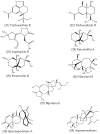Exploring the Promise of Endophytic Fungi: A Review of Novel Antimicrobial Compounds
- PMID: 36296265
- PMCID: PMC9607381
- DOI: 10.3390/microorganisms10101990
Exploring the Promise of Endophytic Fungi: A Review of Novel Antimicrobial Compounds
Abstract
Over the last few decades, many of the existing drugs used to treat infectious diseases have become increasingly ineffective due to the global emergence of antimicrobial resistance (AMR). As such, there is a constant demand to find new, effective compounds that could help to alleviate some of this pressure. Endophytic fungi have captured the attention of many researchers in this field, as they have displayed a vast ability to produce novel bioactive compounds, many of which possess wide-ranging antimicrobial activities. However, while highly promising, research in this area is still in its infancy. Endophytes inhabit the healthy tissues of plants asymptomatically, resulting in a mutualistic symbiosis in which the endophytes produce a plethora of bioactive compounds that support the fitness of the host plant. These compounds display great chemical diversity, representing structural groups, such as aliphatic compounds, alkaloids, peptides, phenolics, polyketides and terpenoids. In this review, the significant antimicrobial potential of endophytic fungi is detailed, highlighting their ability to produce novel and diverse antimicrobial compounds active against human, plant and marine pathogens. In doing so, it also highlights the significant contributions that endophytic fungi can make in our battle against AMR, thus providing the motivation to increase efforts in the search for new and effective antimicrobial drugs.
Keywords: antibiofilm; antimicrobial; antimicrobial resistance; bioactive compounds; endophytes; natural products; novel.
Conflict of interest statement
The authors declare no conflict of interest.
Figures







References
-
- World Health Organisation (WHO) Coronavirus (COVID-19) Dashboard. [(accessed on 16 September 2022)]. Available online: https://covid19.who.int/
-
- Grace D. Infectious diseases and agriculture. In: Ferranti P., Berry E.M., Anderson J.R., editors. Encyclopedia of Food Security and Sustainability. Volume 3. Elsevier; Amsterdam, The Netherlands: 2019. pp. 439–447.
-
- Badawy B., Gwida M., Sadat A., EL-Toukhy M., Sayed-Ahmed M., Alam N., Ahmad S., Ali M.S., Elafify M. Prevalence and Antimicrobial Resistance of Virulent Listeria monocytogenes and Cronobacter sakazakii in Dairy Cattle, the Environment, and Dried Milk with the In Vitro Application of Natural Alternative Control. Antibiotics. 2022;11:1087. doi: 10.3390/antibiotics11081087. - DOI - PMC - PubMed
-
- Singh S.B. Pharmaceuticals: Natural products and natural product models. In: Civjan N., editor. Natural Products in Chemical Biology. John Wiley & Sons, Inc.; Hoboken, NJ, USA: 2012. pp. 287–324.
-
- Kingston D.G.I., Newman D.J. Natural products as anticancer agents. In: Civjan N., editor. Natural Products in Chemical Biology. John Wiley & Sons, Inc.; Hoboken, NJ, USA: 2012. pp. 325–349.
Publication types
LinkOut - more resources
Full Text Sources
Molecular Biology Databases
Research Materials

